Agrifina Terredanio Cabebe A Remarkable Life to Celebrate
June 23, 1928 – December 14, 2020
Alfredo G. Evangelista | Assistant Editor
Folks called Agrifina T. Cabebe in different ways: Aggie, Mrs. C., Ninang, Comadre, The General, The First President of Binhi at Ani and The Mother of Filipino Folk Dance on Maui, to name a few. Her life was anything but ordinary; her family defined her life as one of exploits because Aggie was daring and her life consisted of bold feats. “Many of the things that Mom did were not what everyone else did,” recalled her son Raymond. “Aggie obviously had a long life and it was far from ordinary. In fact, it was quite remarkable.”
No one can dispute Aggie Cabebe’s life was remarkable despite challenges along the way.

Agrifina Terredanio was born in Pa‘ia to Damaso and Marcelina Alvaro Terredanio. Raymond said it was tragic Aggie’s birth parents both passed away at young ages. She and her siblings were raised by the Palos family, initially living in Corn Mill Camp which was at the border between Pukalani and Makawao. When Aggie was about thirteen years old, they moved to Hāli‘imaile. The family’s job was to do laundry for the bachelors.
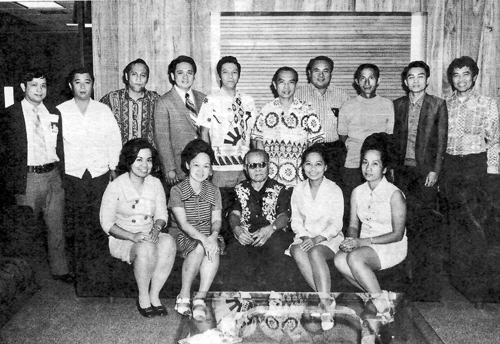
Photo courtesy Cabebe ‘Ohana
Aggie attended Makawao Elementary School and Maui High School at the Hamakuapoko campus, playing saxophone in the band. In those days, students would take off a year of high school to work to help the family. Raymond said Aggie, however, didn’t return to Maui High School and later earned her GED, received stenographer training, learned shorthand and typing and landed a job at Maui Pineapple Company, from which she retired after forty-three years.
In 1948, Aggie married Rafael Cabebe at the Church of the Good Shepherd. (Rafael became president of the Maui Filipino Community Council in 1959.) The Cabebe’s loved to dance. Aggie and Rafael enjoyed ballroom dancing and with a group of like minded friends formed a dance club meeting regularly at Leo Polo’s house. (In 1957, Leo Polo became the first president of the Maui Filipino Community Council.) They called themselves the “Polo Dance Club.”
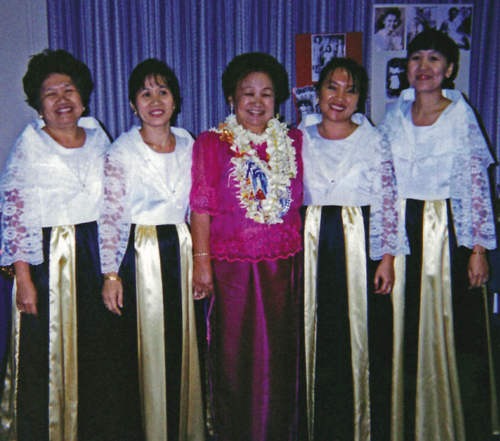
Photo: Cabebe ‘Ohana
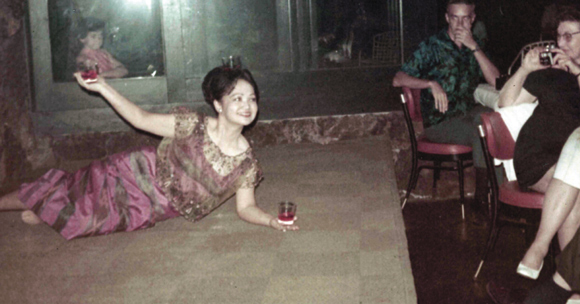
Photo: Cabebe ‘Ohana
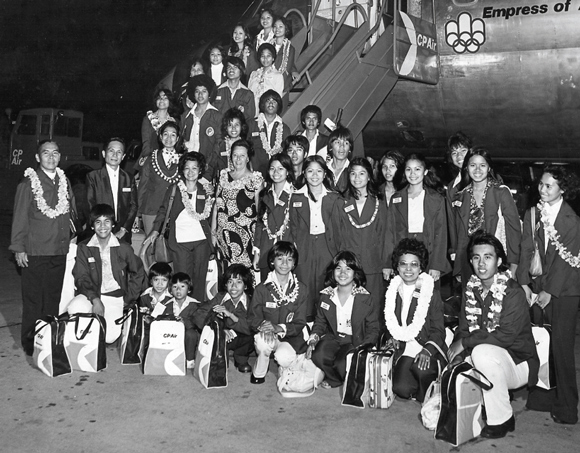
Photo courtesy Alfredo G. Evangelista
Aggie’s legendary journey into promoting Filipino folk dance began in the 1950s when she watched a Filipino folk dance performance by Aurelia Viernes on Maui. Viernes was an exchange student at the University of Hawai‘i at Mānoa, who later started the Filipiniana Dance Academy of Honolulu. Aggie began traveling to Honolulu countless times to learn dances from Viernes.
Initially, Aggie shared her talents with her kids (Raymond claimed he danced for the money while Marcia was very graceful) and their friends, then with other groups in schools, churches, and communities with countless dancers that continued even though she could no longer dance herself.
Aggie formed the Maui Saniatas and they began performing at various locations including the Maui Palms Resort and the Maui Beach Hotel. Among those who performed with her dance troupe were Nita Duldulao and Pauline Agres while the younger dancers—the Maui Saniatas Keiki—included Bernard, Wilburt and Lee Barbero, Jason Paranada, the Romero girls, the Duldulao girls and others.
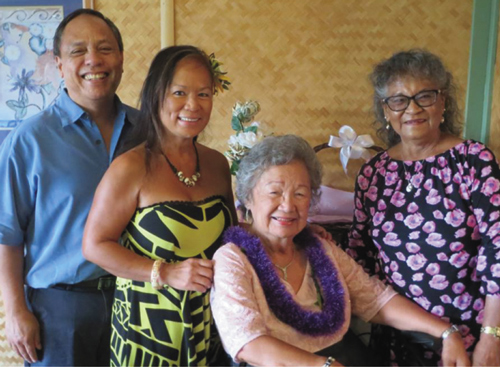
Photo: Cabebe ‘Ohana
“She paid meticulous attention to detail to make sure everything like costumes, music, dance moves, meanings were culturally authentic,” said Raymond. “This was not just for the dance as you witnessed it but to pass on to future generations of Filipinos.”
On a personal note, I and many other youth at Good Shepherd Church learned about Philippine culture from Mrs. Cabebe. In 1972 when I was still in eighth grade at Kahului School, I was part of the Good Shepherd Church Filipino Youth Choir and back then the male voices were changing. The director of the Youth Choir, Manang Nancy Andres, sought out her friend and fellow community activist, Aggie Cabebe, to teach us Filipino folk dances. We started with a few basic dances and entered the Filipino Folk Dance contest at the 1974 Barrio Fiesta and won first place with our performances of Rogelia, Binatbatan/ Sakuting and Ba-o/Maglalatik. We learned more dances and by learning the dances, we learned more about the culture of the Philippines.
Practices were initially held at Mrs. Cabebe house at the corner of Hina and Kamehameha Avenue. The music was loud and energetic and one time even woke up Tata Cabebe who was so inspired by the music he began dancing a bit with us, smiling until Mrs. Cabebe ushered him back into the house.
Later, as the group grew from about a dozen to more than 25, we moved to the church’s parish hall. We learned Igorot dances, Muslim dances, the Spanish era dances, and dances from various parts of the Philippines: Ilocos, Pangasinan, and the Tagalog regions. We brought in Wayne Mendoza and Sabino Geronimo from the Pearl of the Orient in Honolulu as special dance instructors.
Mrs. Cabebe would always patiently lead and teach us the dances. She was very, very, very patient. One time, we were not paying attention—giggling and teasing each other—we didn’t have cell phones at that time so we couldn’t text or go on Facebook. Mrs. Cabebe was not angry at all—she maintained her cool but Manang Nancy was so angry at us for not paying attention she slammed the piano and threatened to stop the dance instruction and let Mrs. Cabebe go home. We were obviously very scared of Manang Nancy and fell silent but Mrs. Cabebe did not bat an eye lash and said, okay let’s take it from the beginning. And yes, we silently followed Mrs. Cabebe’s lead. Through Mrs. Cabebe’s patience, we learned enough dances to perform monthly at the Nāpili Surf Resort and traveled to Honolulu to perform at Shriners Hospital and Lāna‘i for their Rizal Day program. We would perform dances requiring skill and timing like Singkil, Tinikling, Maglalatik, Pandanngo Sa Ilaw, and my favorite—Bangko—where I learned if I fell off sometimes, it would make it look like a more difficult dance. All for a bit of showmanship!
In the fall of 1975, a statewide Philippine Dance workshop was held at Leeward Community College. Mrs. Cabebe and Mrs. Pauline Agres brought three of us—Daniel Idica, John Mario Sevilla, and myself as dancers for the Maui Saniatas to be part of the Pamana ng Lahi conference. The three of us were supposed to be housed cheap—at the Downtown YMCA—but after one look at it, Mrs. Cabebe said no way and brought all of us to the luxurious Ala Moana Hotel, and Mrs. Cabebe took care of all expenses and made sure we were safe.
But the most memorable trip for the Youth Choir was our Summer of 1976 trip to the West Coast. Mrs. Cabebe was specifically assigned to chaperone me and my girlfriend. But in San Francisco, Mrs. Cabebe was paired with a younger dancer and we all were instructed to meet back at the bus at a certain time and to make sure your partner was with you. The bus loaded up and no one said a word until fifteen minutes later, someone said “Where’s Mrs. Cabebe?” We returned back and there she was—waiting patiently. Mrs. Cabebe was apparently shopping in a gift shop and when she came out, we were gone. So throughout the rest of the trip, before the bus would leave our stops, it would become a joke and we would say “Where’s Mrs. Cabebe?”
During our trip, we performed in Vancouver, Victoria, Seattle, and San Juan Capistrano but the highlight of course was performing at the Carnation Plaza at Disneyland. The Carnation Plaza no longer exists but the memories and teachings of Mrs. Cabebe have lasted a lifetime. Beyond learning the intricate dance steps, we learned how to trust each other, how to develop as leaders in our community, and most of all, how important it was to give back to the community.
Aggie took leadership roles in many Filipino community organizations. She served as president of the Maui Filipino Community Council. She worked well with everybody—most of whom have passed—but those still around include Greg Peros, Tony Ramil, Leo Agcolicol and yes Deacon Patrick Constantino—who was the money man–involved in Trophies and Donations and that great money maker—the Souvenir Book.
Mrs Cabebe also served as Vice President and a Board of Governor for the statewide United Filipino Council of Hawai‘i. And she was the first president of Binhi at Ani.
With her friends Nancy Andres and Pauline Agres, she would embark on many new projects in Maui’s Filipino community like the Barrio Fiesta. Mrs. Cabebe became the first chairperson of the Barrio Fiesta while Andres was the General Chairperson of the year’s activities called the Filipino Fiesta. “I’ve attended every single Barrio Fiesta since 1970 when Nancy Andres started it. She was the general chairman back in 1970. I chaired the first Barrio Fiesta with Greg Peros,” said Cabebe in May 2019, reflecting on the 50th Barrio Fiesta. “Fifty years later, we need to continue to perpetuate the Filipino culture for our younger generations. And we need to move forward as a Filipino community on Maui and work together.”
“It was Nancy’s idea to start the Barrio Fiesta. She developed the concept and because she was new on Maui, she worked through some old-timers to get it done,” Cabebe said in 2009 when Andres passed away and the Barrio Fiesta was dedicated to Andres.

Photo: Michelle Santos
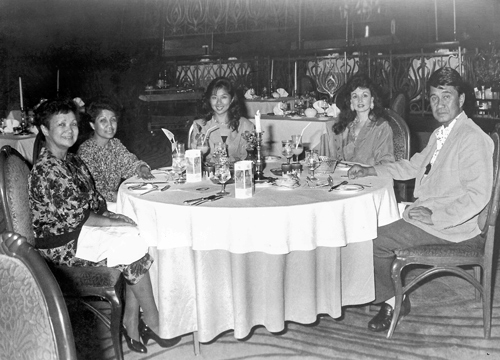
Photo courtesy Cabebe ‘Ohana
Cabebe and Andres also modernized the Miss Maui Filipina pageant. In 1970, the pageant was given a new format that included different phases of competition. “Nancy Andres and I went to the Miss Hawai‘i Filipina contest and we got their criteria and decided to upgrade our Maui queen contest,” recalled Cabebe in June 2019. “We started with three phases: the Kimona Formal Phase; the Talent Phase; and the Terno Phase and Oral Questioning.” Over the years, more changes were made to the Miss Maui Filipina pageant.
The year 1970 was a critical year for the Maui Filipino Community Council. It was the first year of the Council’s Fiesta Filipina, with events spanning from May 1 through July 11, 1970, including an Introduction of the Queen contestants on May 1 with a motorcade from Wells Park to the Kahului Shopping Center; a Santa Cruzan Festival on May 29 at the Kahului Shopping Center; the first annual Barrio Fiesta on May 31, and the Queen Contest and Coronation on June 6 at the Baldwin auditorium. The pageant even published a souvenir program (24 pages).
Cabebe had a lot of respect for Andres and developed a close working relationship with her. “The first time I met Nancy was when she came to Maui in 1964 to perform as part of the Saniatan ti Amianan. That’s why I named my Folk Dance troupe The Maui Saniatas in the late 1960s,” Cabebe recalled. “I got my nickname ‘General’ because I served as the General Chairperson of the Filipino Fiesta for many years, beginning in 1972 when Nancy became president of the Maui Filipino Community Council. When Nancy became president in 1972, I looked for a person to assist with the queen contest and found Pauline Agres,” said Cabebe. “Together, the three of us would be called The Three Musketeers.”
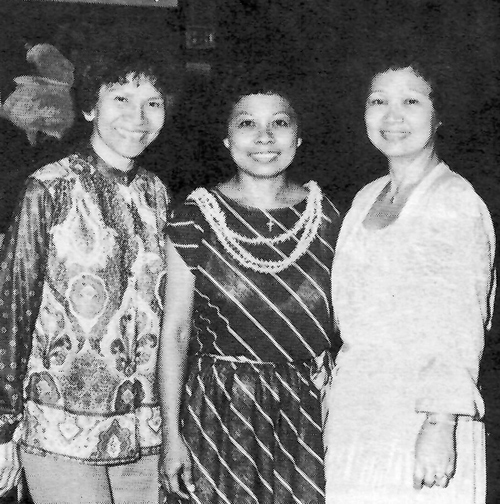
Photo courtesy Cabebe ‘Ohana
Cabebe would collaborate with Andres and Agres on many projects and activities. The Three Musketeers created the Mrs. Valentine pageant—a fundraiser for the Maui Heart Association. For many years, Cabebe was the official Chaperone for the Miss Maui Filipina pageant and would accompany the queen on her official trip to the Philippines. In 1976, a trip to the Philippines was offered as a prize. “I was the first chaperone,” said Cabebe. “Nobody wanted to go. They were scared. I had family in Manila so I wasn’t scared.”
Cabebe was involved in virtually every cultural activity of Maui’s Filipino community. In 1974, as Filipino Fiesta General Chair, she observed “I have had the opportunity of noting how many people gave their time, energy, and talent to the community activities in connection with the Filipino Fiesta projects. I find their contribution very rewarding.”
Cabebe was also a member of a number of commissions and committees: Maui County Status of Women, Maui Community Arts Council, Mayor’s Advisory Committee on Culture and the Arts, and the Maui County Charter Commission.
As to her experience with working with groups and organizations, Cabebe said “If involved in any project, just be dedicated!”
Her selfless dedication would earn her many honors: In 1973, she earned the Outstanding Member Award from the Maui Filipino Community Council. In 2001, she was presented with the Gintong Pamana Leadership Award by the Maui Filipino Chamber of Commerce. In 2003, she was presented by the United Filipino Council of Hawai‘i with a Progress Award in the fields of Humanitarian/Community Service. In 2015, she received the Philippine Arts and Culture Leadership Award from Dance International Production. Also in 2015, she received a Women of Excellence award for Maui County.
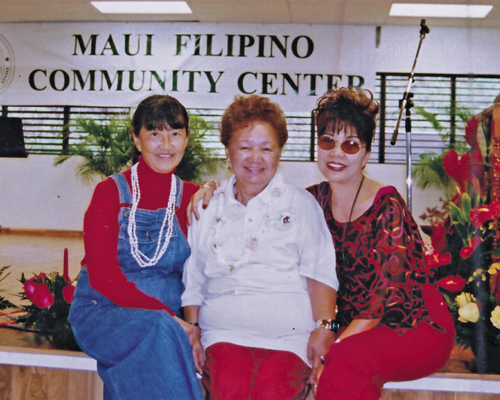
Photo courtesy Cabebe ‘Ohana
Aggie’s commitment to the youth went beyond Good Shepherd: she would teach Filipino folk dance to the Christ the King Jr. Filipino Catholic Club, St Joseph Jr. Filipino Catholic Club as well as many other groups including many Senior Citizen groups. She loved to teach the Rigodon to be performed at celebrations, including the grand opening of Binhi at Ani in January 2005.
But the youth was always her focus.
When Binhi at Ani opened sixteen years ago, Mrs. Cabebe’s wrote: “Truly, we all share a common hope—the future of our youth. And they will remain the focus of our efforts and will continue to spur us into action in the many projects of the community to come.”

Photo courtesy Cabebe ‘Ohana
Indeed, Cabebe’s life will continue to live through the many youth she taught and nurtured. The applause at the end of future performances will always be for Cabebe as well.
In 1999, The Maui News published an article written by Valerie Monson after a testimonial for Cabebe. “The applause that rippled through the Maui Beach Hotel on Saturday night was nothing new to Aggie Cabebe. As the woman who brought the art of Filipino dancing to Maui, she’s been on the receiving end of ovations time and time again. But these cheers weren’t in acknowledgment of a show she’d just finished. This was for the performance of her life.”
The Fil-Am Voice joins the rest of Maui in extending condolences to the Cabebe ‘ohana on their loss. Rest in peace and love, Aggie, we will remember you as we dance each step of your beloved Filipino Folk Dances and we will always miss you—The Mother of Filipino Folk Dance on Maui.
Aloha ‘Oe and Maraming Salamat Po for everything.
 Alfredo G. Evangelista served as President of the Good Shepherd Church Filipino Youth Choir from 1974–1976. He would lead the warm ups and assign who would perform the dances, always making sure he was paired with his high school sweetheart, the former Basilia Tumacder Idica. Together they would be featured as the dancers for Sayaw ed Tapew na Bangko (dance on top of a bench); his favorite dances included Maglalatik, Palu Palo, Pandanngo sa ilaw and Oasioas (he was not agile enough to dance Tinikling).
Alfredo G. Evangelista served as President of the Good Shepherd Church Filipino Youth Choir from 1974–1976. He would lead the warm ups and assign who would perform the dances, always making sure he was paired with his high school sweetheart, the former Basilia Tumacder Idica. Together they would be featured as the dancers for Sayaw ed Tapew na Bangko (dance on top of a bench); his favorite dances included Maglalatik, Palu Palo, Pandanngo sa ilaw and Oasioas (he was not agile enough to dance Tinikling).
